January 25 Scots Book of Days
January 25 – 35 AD The Conversion of Paul feast day.
1308 Marriage of Isabella of France (age 13), daughter of Philip IV King of France to the Prince of Wales, English heir of Philip’s (France’s) enemy, celebrated at Boulogne, 25 January 1308. Pursuant to the terms of the Treaty of Paris (1303), Anglo Franco treaty, the marriage was meant to seal a peace; instead it would produce an eventual English claimant to the French throne itself, and the Hundred Years War. Who knew? Isabella, also known as the She-wolf of France, was Queen consort to Edward II, and mother of Edward III. Isabella was also mother of Joan, who was married at age 7 to the 4 year old Prince David, who became David II King of Scotland just a year later, thus making Joan the Queen of Scots.
1502 proxy marriage of Margaret Tudor and James IV Stewart King of Scots. Patrick Hepburn, 3rd Lord Hailes, 1st Earl of Bothwell one of the plenipotentiaries sent to conclude the treaty for the marriage of King James IV with Princess Margaret Tudor of England in October 1501, and Hepburn stood proxy for the King at the ceremony of betrothal on 25 January 1502.
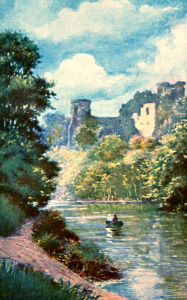 Bothwell Castle. he Spell of Scotland by Keith Clark, 1916 to the Lord Marischall, Boston The Page Company.
Bothwell Castle. he Spell of Scotland by Keith Clark, 1916 to the Lord Marischall, Boston The Page Company.
Ayala attended the marriage by proxy of James IV to Margaret Tudor at Richmond Palace. First there was mass in the chapel, followed by the ceremony itself in the Queen’s Great Chamber. Perkin Warbeck’s widow Lady Catherine Gordon (‘Lady Kateryn Huntleye’) was also present, the daughter of George Gordon, 2nd Earl of Huntly, by his third wife, Lady Elizabeth Hay.
James IV marries Margaret Tudor – 1503. James marries Margaret, sister of King Henry VIII of England. This important marriage gave the Tudors credibility but also gave an offspring a claim to the English throne. Video: A history of Scotland: Language is Power.
http://www.bbc.co.uk/scotland/history/the_stewarts/james_iv_marries_margaret_tudor/
1599 never happened in Scotland. (Scotland went to January 1st 1600 for the calendar year.) The previous January 25 was the year 1598. There was no January 1st 1599 to March 24th of the year 1599 in Scotland. New Year’s Day began from 1600. The Scottish year 1599 was 10 months from March 25th to December 31st. Scotland and England kept different calendars (at least from January to March 24) for the next century and a half For the previous 15 centuries, from the time of Julius Ceasar, the new year began with the Spring Equinox, or March 25th, called Lady day in England. Hence September was the 7th month from March, from the Latin Septiem for seven. October the 8th month from the Latin octo for eight, November the 9th month from the Latin Novem for nine. And December from the Latin Decem for 10, or the 10th month of the year. . From 1155 to 1751 England and its colonies New Year began on 25 March and begin January 1 as start of year in 1752.
1751 did not occur in England, Ireland, British North America, and British colonies, as 1751 only had 282 days due to the Calendar Act of 1750. Scotland had already partly made the change: the year began on 1 January in 1600.
1759 Robert Burns (1759–1796) born Alloway, Ayr, Scotland. A century and a half before the Bard was born, in 1628, Andrew Millar III, fresh from Glasgow University, was first assigned to St. Mungo, the parish church of Alloway.
Before the Reformation [1560], this church, St. Mungo, had been a prebend of the Chapel Royal of Stirling; in 1690, the parishes of Alloway and Ayr were united and St. Mungo’s fell into disrepair; but in the interval, a succession of reformed ministers served there.
The roofless structure stands today [ circa 1960], a short distance upstream from the Brig o’ Doon; in the 18th century Robert Burns made it the scene of the midnight revel in his Tam o’Shanter.
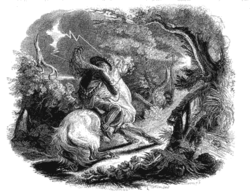 Contemporary woodcut showing Tam wearing his bonnet and sitting astride his horse Meg.
Contemporary woodcut showing Tam wearing his bonnet and sitting astride his horse Meg.
Shanter is some twelve miles south of Ayr; the site of Tam’s house, though the dwelling has gone, is identifiable. There, on nights when Tam and his crony Souter Johnny stayed overlong in an Ayr pub, sat his wife Kate ‘nursing her wrath to keep it warm.’
At the end of one market day, Tam ‘got planted unco right”; towards midnight, oblivious to a tremendous storm, he start home.
‘Kings may be blest but Tam was glorious,
O’er all the ills of life victorious.’
When his grey mare Meg reached ‘Alloway’s auld haunted kirk’ he saw light pouring from every opening: within, with Auld Nick supplying the skirling music, witches and warlocks flaunted themselves. Glimpsed through the flinging dancers, Tam saw on the Holy Table such stomach-turning exhibits as murder weapons still sticky with gore, skeletons of unchristened babes,
‘Three lawyers’ tongues, turned inside out,
Wi’ lies seamed like a beggar’s clout.’
But as the dance went on, he noticed among the grotesques ‘ae winsome wench and wawlie’: [YYMA 51]
‘Her cutty sark, o’ Paisley harn,
That while a lassie she had warn,
In Longitude tho’ sorely scanty,
It was her best, and she was vauntie…..’
Abandoning caution, Tam let his admiration run away with him, and shouted
‘Weel done, Cutty-sark 1′
At the sound, the church blackened; suddenly all the fiends inside rushed out in hot pursuit. Tam spurred Meg toward the Brig o’ Doon, knowing that such creatures dare not cross running water. The leap that took them over the hump brought safety—but at the cost of the mare’s trailing tail.
John Gibson Lockhart, aided by Allan Cunningham.
Lockhart of Bar 1297 2Miller 2Simmons 2Choate 2Sorensen
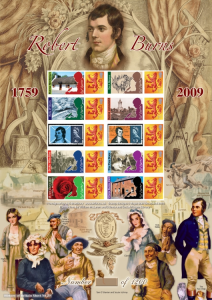 250th birthday anniversary postage for Rabbie Burns.
250th birthday anniversary postage for Rabbie Burns.
1817 The Scotsman begins s a liberal weekly newspaper by lawyer William Ritchie and customs official Charles Maclaren in response to the “unblushing subservience” of competing newspapers to the Edinburgh establishment. The paper was at at 257 High Street on the Royal Mile in Edinburgh, and pledged to “impartiality, firmness and independence”. After the abolition of newspaper stamp tax in Scotland in 1850, The Scotsman was relaunched as a daily newspaper priced at 1d and a circulation of 6,000 copies.
1825 Scotsman Robert L. Campbell, 25 Jan 1825, Glasgow, Renfrew, Scotland, died 11 april 1874, became Utah’s most prominent superintendent of public education. CONVEYANCE & CONTRIBUTION: MORMON SCOTS GATHER TO AN AMERICAN ZION, History Scotland magazine – Vol.5.4 – July/August 2005
Map shows Glasgow in the middle, surroundede by Renfres, Langside, Largs, Hamilton, Dalry, Bothwell, Edinburgh, Pentland Craigmillar, Dalkeath, Seton, Dunfermline, Loc Leven Stirling, Graham,
1832 Joseph Smith the Prophet, at Amherst, Ohio, (clan Mack of Inverness, Malcolm King of Scots), Doctrine and Covenants 75. Be filled with joy and gladness.
1890 Nellie Bly, born Elizabeth Jane Cochran. Arrives in New Jersey. Bly left by steam ship for a trip around the world to beat Phileas Fogg, the fictional hero of Jules Verne’s “Around the World in Eighty Days.” A private train brings her from San Francisco to New jersey in 4 days. “Seventy-two days, six hours, eleven minutes and fourteen seconds after her Hoboken departure” Bly was back in New York. She had circumnavigated the globe almost unchaperoned.
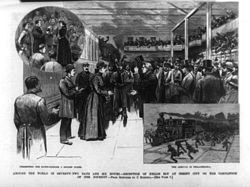 A woodcut image of Nellie Bly’s homecoming reception in Jersey City printed in Frank Leslie’s Illustrated News on 8 Feb 1890. (clan Cochran)
A woodcut image of Nellie Bly’s homecoming reception in Jersey City printed in Frank Leslie’s Illustrated News on 8 Feb 1890. (clan Cochran)
1946 ‘My Reputation’ movie released. The character is the widow Mrs. Jessica Drummond (Barbara Stanwyck, of Scots descent as Ruby Catherine Stevens) of an ancient Scottish clan. Reputation is a War movie, with lots of military uniforms, a quote from Shakespeare. Characters with Scots names are always more interesting.
Among all the Dramatic Triumphs from Warners this one is the greatest! Barbara Stanwyck will be famed for all time as ‘Jess’ is My Reputation.
1986 Space Shuttle Challenger’s crew, including McAuliffe (1948) for NASA’s Teacher in Space Project and Ronald Ervin McNair, Ph.D. (1950) again try and fit into their space suits. Weather major cold front has settled over Florida. Tourist sites and orange groves concerned.
 Sharon Christa Corrigan McAuliffe (September 2, 1948 – January 28, 1986). STS-51-L
Sharon Christa Corrigan McAuliffe (September 2, 1948 – January 28, 1986). STS-51-L
1996 Robert Burns 237th anniversary of birth. Commemorative stamps.
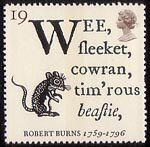 ‘To a Mouse’ and Fieldmouse, 19 Wee fleeket, cowran, tim’rous beastie,
‘To a Mouse’ and Fieldmouse, 19 Wee fleeket, cowran, tim’rous beastie,
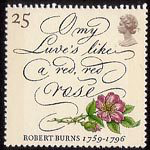 ‘O my Luve’s like a red, red rose.’
‘O my Luve’s like a red, red rose.’
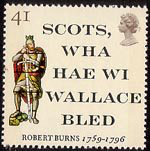 ‘Scots, wha hae wi Wallace bled’
‘Scots, wha hae wi Wallace bled’
2009 Robert Burns 250th anniversary of Birth. Rabbie Burns
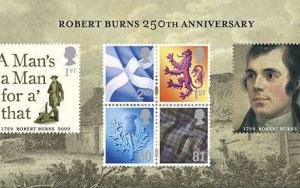 A Man’s a Man for a’ that. Thistle, flag St Andrews cross, lion rampant, tartan
A Man’s a Man for a’ that. Thistle, flag St Andrews cross, lion rampant, tartan
2015 Burns night.
http://www.staonlineshop.co.uk/
Utah Standard News depends on the support of readers like you.
Good Journalism requires time, expertise, passion and money. We know you appreciate the coverage here. Please help us to continue as an alternative news website by becoming a subscriber or making a donation. To learn more about our subscription options or make a donation, click here.
To Advertise on UtahStandardNews.com, please contact us at: ed@utahstandardnews.com.


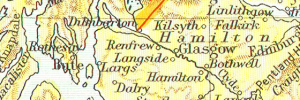
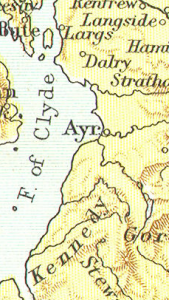
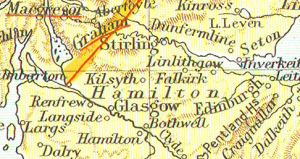
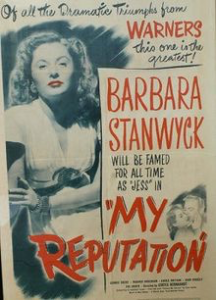

Comments - No Responses to “January 25 Scots Book of Days”
Sure is empty down here...